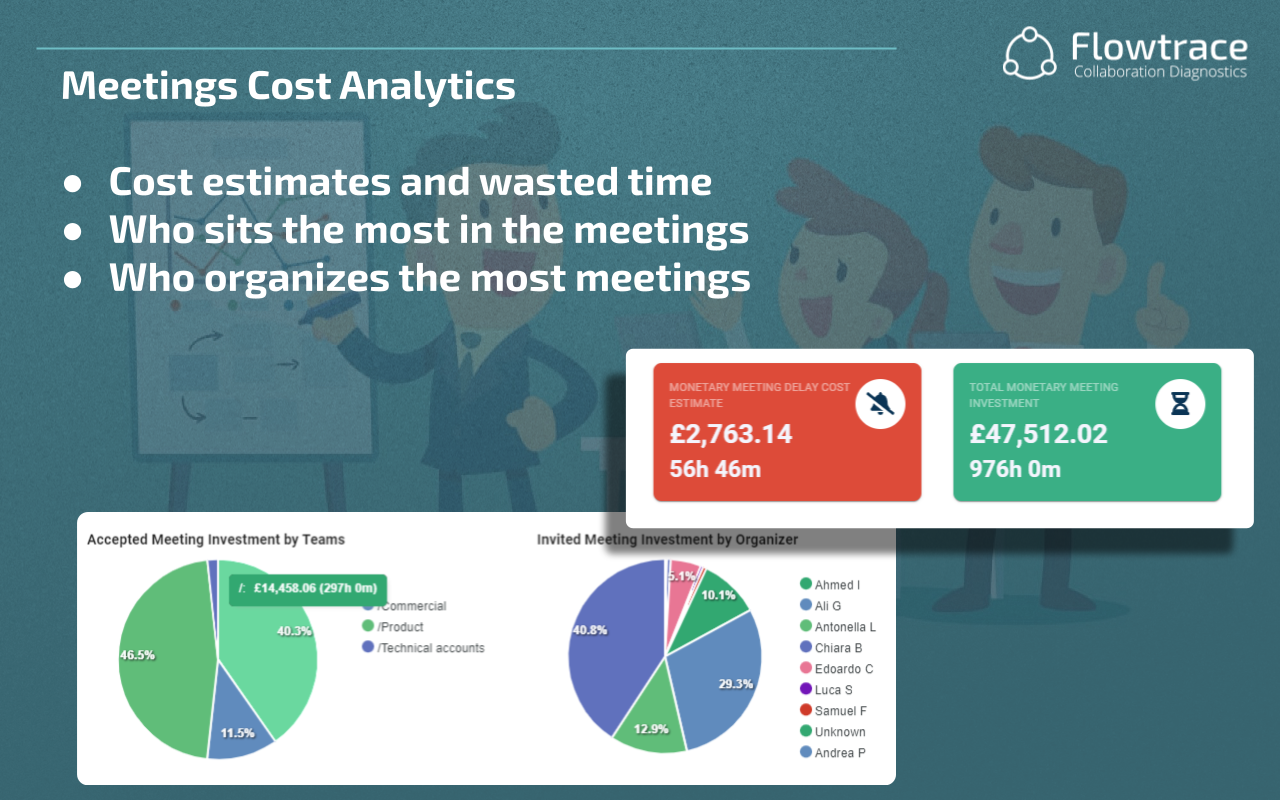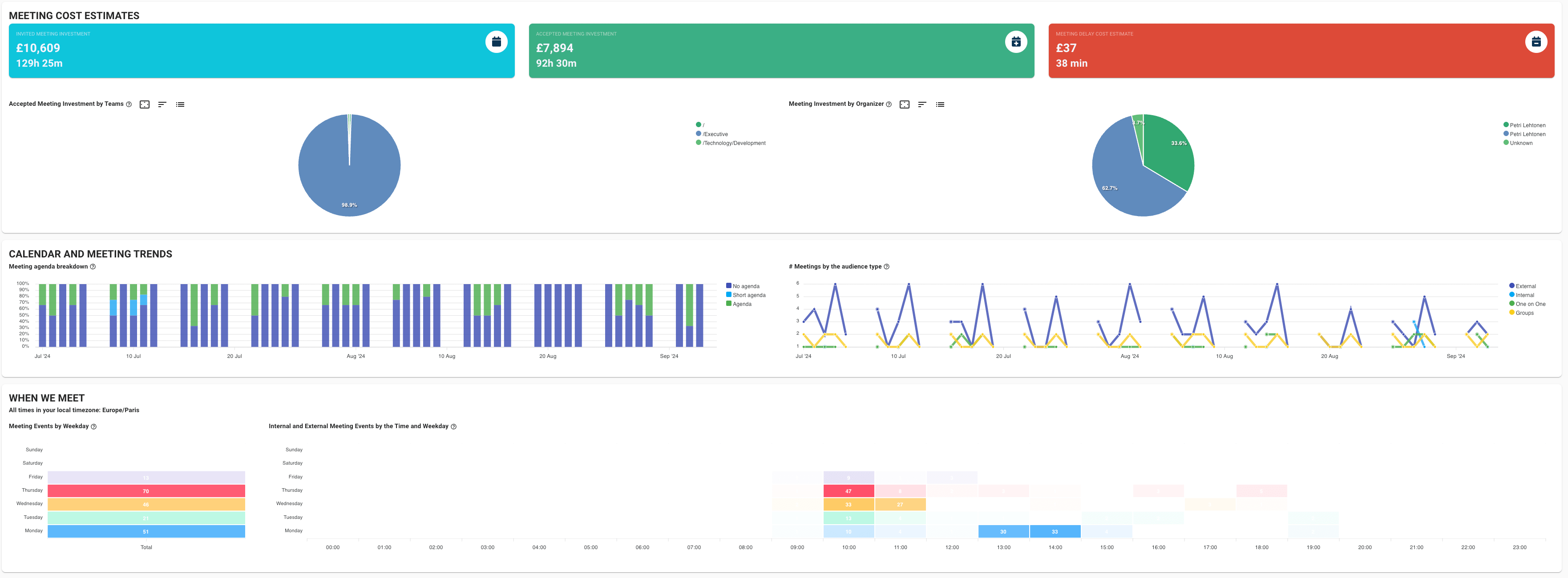Key Metrics For Assessing Meeting Effectiveness
Optimize meeting effectiveness with data-driven metrics on preparation, cost, participation, timing, and accountability to enhance productivity and...
Learn the different KPIs for meetings and how to measure participation, costs, and outcomes to transform inefficiency into productivity and drive organizational success.
Are your meetings benefiting your organisation or just filling up the calendar? Without Key Performance Indicators (KPIs) for meetings, you are missing out on critical insights that could turn inefficiency into productive strategies for your teams. KPIs such as participation, duration, and outcomes, shed light on the true effectiveness of your meetings and meeting culture in general. Time is as valuable as any asset on your balance sheet and understanding these metrics can spell the difference between stagnation and growth. If you're ready to turn every meeting into a strategic asset, it’s time to dive deeper into what KPIs can do for you.
Purpose: This metric tracks the number of meetings conducted without a predefined agenda. By monitoring how often meetings occur without a clear plan, organizations can assess the extent to which their meetings may lack focus or direction.

Why: An agenda serves as a roadmap for any meeting, outlining the topics to be discussed and the objectives to be achieved. When meetings lack an agenda, they are more likely to go off-track, waste time, and result in unclear outcomes. Tracking this metric highlights the importance of preparation and can prompt improvements in meeting planning, ensuring that every session is purposeful and productive.
Purpose: The Meeting Investment Cost metric quantifies the total cost of meetings by calculating the combined salaries of all participants and the time they spend in meetings. This provides a tangible figure representing the financial resources allocated to meetings within the organization.

Why: Understanding the financial impact of meetings is crucial for optimizing budget allocations and resource management. By knowing the exact cost associated with each meeting, organizations can make more informed decisions about which meetings are necessary and how they can be streamlined.
This metric helps identify opportunities to reduce unnecessary meetings, shorten durations, or refine participant lists, all of which contribute to more cost-effective operations.
Purpose: This metric calculates the potential cost of a meeting by considering the salaries of all invited participants, whether they attend or not. It provides an estimate of the financial resources that could be allocated to the meeting based on the number and roles of those invited.

Why: The Invited Meeting Investment metric is essential for strategic decision-making when it comes to determining who should be invited to meetings. By understanding the potential cost implications of inviting large groups or high-salary individuals, organizations can be more selective in their invitations. This can lead to more focused meetings, reduced costs, and a greater emphasis on ensuring that only those whose input is crucial are involved.
Purpose: This metric reflects the actual cost of a meeting by calculating the salaries of participants who accepted the invitation and attended the meeting. It provides a more accurate representation of the financial impact, as it accounts only for those who were present.

Why: Accepted Meeting Investment is a critical metric for obtaining a realistic assessment of meeting costs. By focusing on the actual attendees rather than just the invitees, organizations can better understand the true financial implications of their meetings. This insight allows for more precise budgeting and helps identify patterns where certain meetings consistently attract high costs, prompting a review of their necessity or structure.
Purpose: This metric estimates the cost incurred due to delays in starting meetings. It calculates the financial impact of lost time when meetings do not begin as scheduled, considering the combined salaries of the participants during the delay period.

Why: Punctuality in meetings is more than just a matter of professionalism; it has a direct financial impact. The Meeting Delay Cost Estimate emphasizes the importance of starting meetings on time by making the cost of delays visible. This awareness can drive improvements in time management and punctuality across the organization, reducing unnecessary costs and reinforcing a culture of respect for everyone’s time.
Purpose: This metric analyzes the contents of meeting agendas to ensure that they are relevant and aligned with the meeting’s objectives. It breaks down the agenda items to assess their importance, clarity, and contribution to the overall meeting goals.
Why: A well-structured agenda is crucial for maintaining focus and productivity during meetings. The Meeting Agenda Breakdown metric helps organizations ensure that every agenda item is necessary and contributes to the meeting's purpose. By regularly analyzing agendas, organizations can avoid unnecessary discussions, keep meetings on track, and ensure that all participants are prepared to address the most critical topics. This leads to more efficient meetings and better use of time.
Purpose: This metric categorizes meetings based on the type of audience involved, such as internal teams, external clients, or a mix of both. It tracks the distribution of meetings across these different audience types to understand how resources are allocated.

Why: Tailoring meeting strategies to the specific audience type is essential for achieving desired outcomes. Internal meetings may focus on operational efficiency, while external meetings often require a different approach, emphasizing client satisfaction and relationship-building.
By categorizing meetings by audience type, organizations can better align their strategies with the needs and expectations of the participants, ensuring that each meeting is conducted in a way that maximizes its effectiveness and relevance to the audience. This approach helps in optimizing the content, format, and timing of meetings based on who is attending, leading to more successful and impactful interactions.
Purpose: This metric tracks the distribution of meetings across different weekdays to understand when meetings are most frequently held. It provides insights into the concentration of meetings on specific days.

Why: Identifying patterns in the scheduling of meetings is crucial for optimizing overall productivity. By understanding which days are most meeting-heavy, organizations can take steps to balance the workload, avoid overscheduling, and reduce meeting fatigue.
This metric helps in planning meetings more strategically, ensuring that critical meetings are not bunched together on the same day, which can overwhelm participants and diminish the effectiveness of discussions.
Purpose: This metric analyzes the start times of meetings to determine when they are most frequently scheduled. It helps identify the hours during which meetings are most likely to be productive based on participant energy levels and availability.
Why: The timing of a meeting can significantly influence its effectiveness. Meetings scheduled during participants' peak energy levels are more likely to be productive and engaging. By analyzing the most common starting hours, organizations can guide their scheduling practices to align with when participants are most alert and available.
This alignment helps in maximizing focus and ensuring that meetings are conducted when attendees are best prepared to contribute, leading to more efficient and effective outcomes.
Purpose: This metric monitors the number of direct meeting invitations sent within the organization. It tracks how often employees are invited to meetings and by whom, focusing specifically on internal communication.

Why: Measuring internal direct invites is important for assessing the efficiency of communication and collaboration within the organization. A high number of direct invites could indicate active internal communication, but it could also suggest over-invitation or unnecessary meetings.
By monitoring this metric, organizations can ensure that internal meetings are purposeful and that the right people are being invited, thereby optimizing collaboration without overwhelming employees with too many meetings.
Purpose: This metric encourages the practice of marking certain meeting invites as optional, particularly when a detailed agenda is provided. It focuses on empowering attendees to make informed decisions about their participation based on the agenda's relevance to their roles.
Why: Implementing optional invites can significantly enhance productivity by allowing team members to opt out of meetings that may not require their direct input. This approach reduces the fear of missing out (FOMO) by ensuring that all necessary information is detailed in the agenda, giving employees the confidence to skip meetings without worrying about missing critical information.
Optional invites also help in decluttering calendars and redirecting time towards high-priority tasks, promoting a more focused and efficient work environment. By enabling employees to attend only those meetings where they can add or gain value, organizations foster a culture of respect for individual time and contributions, which can lead to increased job satisfaction and overall efficiency.
Purpose: This metric analyzes the composition of meeting invitees, detailing who is being invited and their roles within the organization. It breaks down invitees by department, seniority, and relevance to the meeting’s objectives.
Why: Ensuring that all necessary stakeholders are included in a meeting without overloading the attendee list is crucial for maintaining efficiency and effectiveness. The Meeting Invitee Breakdown metric helps organizations strike the right balance by analyzing who is invited to meetings.
This prevents the common issue of "over-invitation," where too many people are included in meetings without a clear need for their presence, leading to unnecessary costs and diluted discussions. By carefully analyzing this breakdown, organizations can tailor meetings to include only those who are essential, ensuring that discussions are focused and decision-making is more streamlined.
Purpose: This metric provides a cumulative count of all meetings held within a specified period. It tracks the total number of meetings across the organization, offering a high-level view of meeting activity.

Why: Monitoring the total number of meetings is essential for overall workload and resource management. A high number of meetings may indicate a culture of over-meeting, which can lead to reduced productivity and burnout. Conversely, too few meetings might suggest insufficient communication or collaboration.
By tracking this metric, organizations can balance their meeting culture, ensuring that the number of meetings is appropriate and aligned with their strategic goals, while also managing the workload on employees.
Purpose: This metric tracks the effectiveness of follow-up actions that are decided during meetings. It measures whether the assigned tasks or decisions are implemented as planned and monitors the accountability of those responsible.
Why: Ensuring that meetings result in actionable outcomes is critical for their success. The Follow-Up Actions and Accountability metric helps organizations ensure that decisions made during meetings are executed and that responsibilities are clearly understood and met. Without effective follow-up, meetings can become a waste of time, with important decisions or tasks falling through the cracks.
By tracking this metric, organizations can improve accountability, ensure that meetings lead to tangible results, and reinforce the value of each meeting in achieving business objectives.
Tracking and analyzing meeting KPIs is essential for enhancing productivity and efficiency within any organization. By carefully monitoring these key metrics—ranging from meeting preparation and participation to outcomes and follow-up actions—organizations can gain valuable insights into their meeting practices. These insights allow for informed decision-making, better resource management, and the identification of areas where improvements can be made to optimize meetings.
Discover these meeting metrics with Flowtrace and drive your meeting culture forward today.
Optimize meeting effectiveness with data-driven metrics on preparation, cost, participation, timing, and accountability to enhance productivity and...
Improve meeting agenda effectiveness with this simple guide. Discover key strategies to improve clarity, time management, and decision-making for...
Optimize your meetings with a data-driven approach. Learn how to analyze key metrics to improve efficiency, reduce costs, and enhance collaboration.